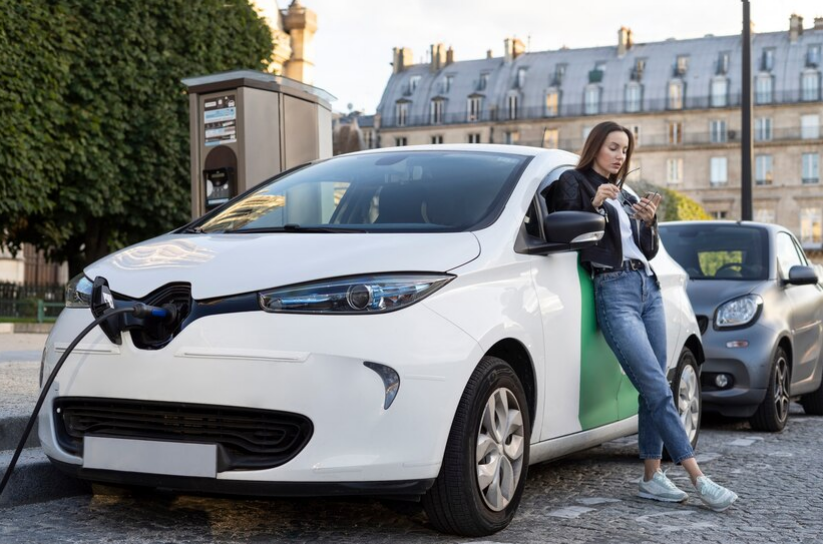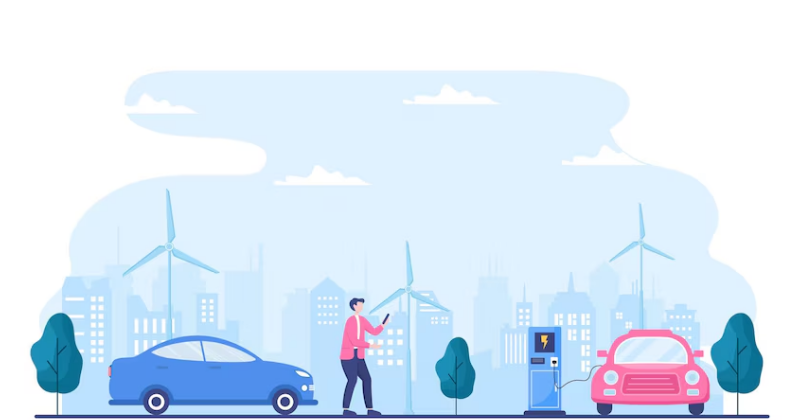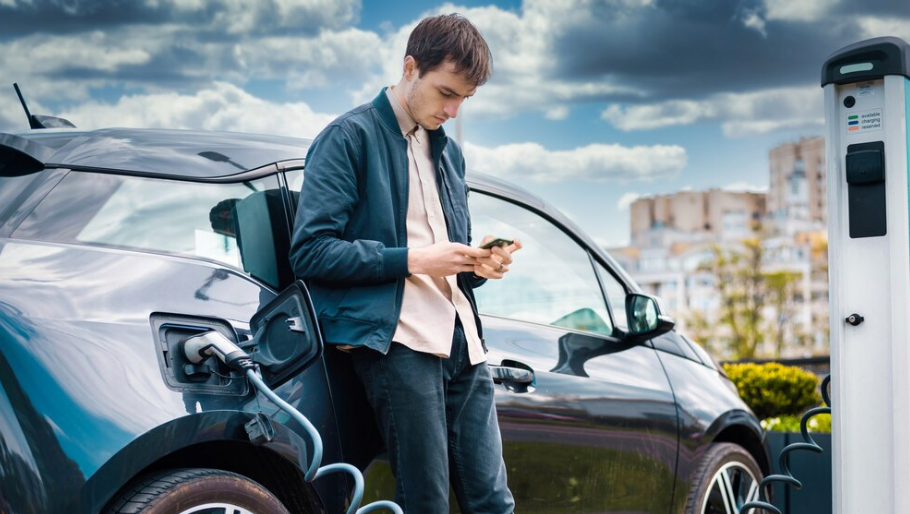Let’s discuss about Electric Vehicles: Transforming the Future of Transportation so the changeover from internal combustion engine vehicles to electric cars (EVs) is considered to be one of the greatest changes in transportation. Due to the environmental issues, we are facing, and a desire for renewable energy solutions electric vehicles are being promoted significantly as another way of lessening carbon emissions and require for fossil fuels. This blog post will explore the history, advantages and challenges of Electric Vehicles (EVs) with a focus on what they mean for the auto industry and beyond
Electric Cars Have Changed
The idea of an electric vehicle is not novel. Electric Vehicles have been around since the late 19th century, but modern technology has made then more viable only in recent times. The first models were plagued by poor range, long recharge times and high prices. But we have come a long way in the last few years, so most of them are not there anymore.
A Brief History
1830s: The first small scale electric cars were developed; however, they were not practicable for standard use.
1890s: Electric cars became popular in the United States, with manufacturers like Baker Electric and Detroit Electric leading the way.
Early 20th Century: The rise of gasoline-powered cars, with their longer range and lower cost, overshadowed electric vehicles.
1900s: This decade would start out slowly for EV’s as the gasoline-powered car with its longer rang and lower initial cost, dominated auto sales.
1970s: The oil crisis put electric cars back on the radar but massive technological hurdles arguably killed off many of what might have been mainstream contenders for widespread consumer adoption.
1990s: The General Motors EV1 made its debut but it was to be short-lived as a result of economics and politics.
2000s-Present: Companies such as Tesla revolutionized the market with advanced battery tech, improved range and futuristic designs which made EVs a worthwhile alternative to traditional vehicles.

Benefits of Electric Vehicles
Electric vehicles are seen as being cleaner, faster, quieter and more efficient than their internal-combustion-engine-driven cousins. This has important implications not only for the environment, but also economically and socially.
Environmental Benefits
Lower Emissions: Because of this, when emissions are measured by the tailpipe lots if not all greenhouse gases and air pollutants that contribute to local diseases or poor health can be significantly reduced. This will be vital for the battle against climate change and to help prevent further air pollution in cities
Enjoy renewable Energy Efficiency: the system is more efficient than internal combustion engines, converting a larger share of energy from battery into motion. So, overall, the EVs end up consuming less energy to get from place A on map 1 to roughly equivalent point B on new map.
Economic Benefits
Reduced Operating Expenses: EVs have fewer moving parts than internal combustion vehicles, which means less wear and tear on brakes & Tyres. Moreover, electricity costs less than petrol in most areas, hence lower fuel expenses.
Energy Independence: EVs help reduce dependence on imported oil by running only on the electricity, enabling countries to be energy independent.
Societal Benefits
Health Benefits: The number of respiratory, and cardiovascular diseases linked to poor air quality could be significantly lowered by reduced levels on emissions caused as a result of EVs
Employment: The industry around BEVs is a booming, in the establishment of manufacturing facilities and battery materials production as well as infrastructure development across the country.
Barriers to Electric Vehicles
Although they are superior in many ways, EVs do have a number of challenges that need to be overcome for more widespread usage.

Range Anxiety
The biggest theme of worry among those considering an EV surrounds range anxiety—the fear that the vehicle will run out charge before reaching its destination. The fear of running out of charge heads the list, even though modern EVs have more than enough range for most drivers today (unless you live in an area lacking a strong charging infrastructure).
Charging Infrastructure
Charging infrastructure and its easy availability is key to the success of electric vehicle as it solves not just charging issue but confidence issue in using them. That’s fine in an urban environment, where charging infrastructure exists and is becoming more resilient every day, but it creates a barrier to EV ownership for many rural or less developed regions than we have in the United States.
Battery Technology
The battery is the most expensive part of an EV and has massive environmental (and human rights) implications. More attention needs to be paid on the issues like mining of raw materials (e.g. lithium, cobalt) and aspect about recycling batteries for sustainable development.
Initial Cost
While the lifetime cost of ownership stands to be lower compared with buying a gas-powered vehicle, initial purchase prices on an EV can run higher. This initial investment keeps some consumers away despite the fact that it will pay for itself in the long run.
Electric Grid Capacity
This increase in EVs lead to the demand of electricity, as there are more and more electric cars on the road. The local electrical grid must be able to handle this additional load, especially during peak charging times in order to prevent outages and maintain reliability.
Technological Advancements
The problems will be overcome with technological advances. New advances in battery technology, vehicle design and charging infrastructure are preparing the market for EV 2.0
Battery Technology
Solid State Batteries: These are among the biggest promises of time as they offer higher energy density, faster charging and look to be safer than traditional Lithium-Ion batteries. However, companies such as Toyota and Quantum cape are leading the way in this field.
Battery recycling: Development in Recycling technologies is an essential component for the end-of-life management of EV batteries. Recycling processes can be done in such a way that the material gets more value and with less impact on our earth.
Charging Infrastructure
Charging Forward: Networks of fast charging stations, such as Tesla’s Supercharger and Electrify America, are growing to offer quicker charge times on the road so owners can reach destinations in shorter periods.
Inductive Charging: EVs that connect with a wireless grid-so they never have to be plugged in-are not just science fiction.
Vehicle Design
Lightweight Materials: Carbon fiber and aluminum can also improve the efficiency (and ultimately range) of EVs by reducing overall weight.
Aerodynamics: Further improving aerodynamic designs can reduce the drag to increase efficiency for electric vehicles.

Government policies & incentives:
EV adoption is largely dependent on the government policies and incentives. Around the world, different guidelines are being put in place to push drivers and builders toward EVs.
Subsidies and Tax Credits
Most governments around the world also provide various subsidies and tax credits in order to lower upfront purchasing costs for an EV. These monetary rewards help balance the playing field for EVs against traditional cars.
Emissions Regulations
Stringent emissions norms are compelling auto manufacturers to venture into clean technology including EVs. Electric mobility is driven by policy, such as the European Union CO2 emission standards and California’s Zero Emission Vehicle (ZEV) program.
Infrastructure Investment
As more EVs hit the road, governments are investing in charging infrastructure. These include not just the U.S. Federal Highway Administration’s Alternative Fuel Corridor Plan, but also China’s massive EV charging infrastructure plans for 2020 undertaken nearly six years ago.
Funding for Research and Development
State governments should initiate public funding to research and develop EV technology, including affordable battery along with sustainable manufacturing practices.
Electric Vehicles of Tomorrow
However, the progress and adoption of electric vehicles in other areas show a bright future for EVs which is likely to signify a huge transformation within the automotive industry. Revealed, such trends and developments likely to set forth the direction for EVs.
Autonomous Electric Vehicles
Both autonomous driving and electric vehicles are on a trajectory to greatly change our current form of transportation, and the two seem poised for convergence. Waymo, Tesla and GM are in a race to manufacture an autonomous electric car that could drastically improve road safety, alleviate gridlock with new vehicle fleets-for-hire-and-ride services-such as the ride pools companies like Uber already offers.
Vehicle-to-Grid (V2G) Technology
V2G gives EVs a way of connecting with the grid, working as an energy storage medium and/or offering demand response services. The project is part of what some see as the future for EV makers: leveraging millions of electric vehicles to jointly help stabilize the grid, support renewable energy integration and offer new revenue streams for EV owners.
Global Market Expansion
Lower battery costs, better charging infrastructure and the falling cost of renewables will allow EVs to spread in every corner of the world. EV industry has a lot of potential in emerging markets, especially in Asia and Latin America.
Hybrid with Renewable Energy
The other thing is that EVs can be integrated with renewable energy sources, like solar and wind power which makes more of a mature ecosystem for sustainable energy. This integration will be enabled by smart grid technology and energy management systems.
Batteries from EVs and Second-Life Applications
Battery capacity declines when an EV battery becomes degraded, but it can still be used for low-level tasks. This will help extend battery life and reduce waste by giving it a second life in home energy storage or backup power systems.
Urban Mobility Solutions
On the path to transforming urban mobility, electric vehicles have a significant role. Cities are starting to see more and more electric buses, bikes, or scooters running around as a cleaner alternative to traditional vehicles.
Success Stories Case Study
Tesla
We all basically understood that Tesla was the pioneer in electric vehicles, with a bunch of high-performance EVs and batteries from everywhere along with an extensive Supercharger network. The success of the company has attracted much investment and attention to the burgeoning EV space.
NIO
NIO, a Chinese automaker who has to date seen some success in the EV space with its premium electric SUVs and battery swap technology. A Trouble-Free Future for NIO’s success in China underlines the unstoppable rise of electric cars to meet increasing buyer demand and transformation toward a simpler future auto industry.
Volkswagen
That is shown in the company’s dedication to electrification, like with its ID. electric vehicle lineup demonstrates incumbent automakers are transitioning to EVs as well. The investment in EV production and battery technology by the company is establishing it as a key player when electric mobility takes over.
BYD
China’s BYD leads the charge in electric vehicles, batteries globally Its products cover electric cars, buses and now trucks, a hat trick that underscores the versatility of electric power.
Conclusion
There is a paradigm shift in the automobile industry going on to move towards electric vehicles for sustainable mobility. Though great obstacles still exist, the technology, policy support and consumer interest has put EVs in a game where they have every opportunity to win. The world is changing to a cleaner, more efficient lifestyle and electric cars could play an important role in how we move around the globe.
Electric vehicles are not just a fad, they are the future of transport. Meeting this challenge will mean more innovation, collaboration and investment – but the rewards are clear: lower emissions Better Health -Reducing air pollution improves public health by reducing premature deaths, hospital admissions for respiratory disease and treatment costs reduced imports of fossil fuels promote energy security fostering economic stability.
Which batteries are used in electric vehicles?
Electric vehicles primarily use lithium-ion batteries due to their high energy density and efficiency. Other types include lithium iron phosphate (LiFePO4) for safety, solid-state batteries for future potential, and nickel-metal hydride (NiMH) for hybrids. Lead-acid batteries are outdated and used mainly for auxiliary power.
Which country produces the most electric vehicles?
China produces the most electric vehicles (EVs) globally. It leads in both manufacturing and sales of EVs, driven by significant government support, a large domestic market, and extensive production capacity. Major Chinese EV manufacturers include BYD, NIO, and Xpeng, contributing to China’s dominant position in the EV market.

